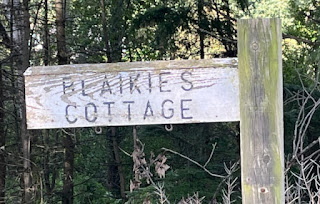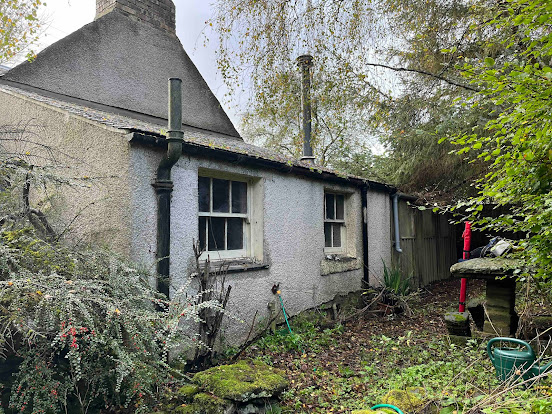 |
| Credit: Author |
Introduction
If you travel north into Earlston, about 100 metres before the bridge over the river Leader, there is a modest, weather-beaten sign pointing towards 'Blaikie's Cottage'. The sign may be modest, but the cottage was home to James Blaikie, a deeply pious man, an eccentric, respected businessman, a miser, and a man of great physical strength.
Considering that more than 260 years since the last Blaikie died and that the house is still referred to as Blaikie's Cottage is evidence of his lasting impression on the village.
The Killing Times
James’ religion was central to his life, but there were threats to his faith from the Scottish Episcopalians, the 1689 Jacobite Rising and the 1715 and 1745 rebellions. The danger to his life and religion must have seemed endless.
Born in 1674, James witnessed the end of the Covenanters era which, because of the atrocities was known as the Killing Times.
In 1684, the Privy Council passed the Oath of Abjuration. This Oath required all Scots to swear that the monarch was above the church, something Presbyterians could not agree to. Those who refused to swear were either executed or banished.
Even though just a ten-year-old, James most likely heard of local people who were banished. John Young and Andrew Cook from Melrose were banished, as were Robert McGill and Robert Young from Galashiels, together with William Hardie and John Mather of Kelso and Jedburgh, respectively.
Where these men were banished to and if they survived is not known. However, an indication of their fate can be taken from the account of Gilbert Milroy of Penninghame parish in Dumfries.
Milroy was taken prisoner and was ordered to take the Oath. He refused and was taken to Edinburgh. Held at Holyrood, he was again ordered to take the Oath. Again, he refused. He was sentenced to have his ears cut off and be banished.
He was taken to Newhaven, where he and another 130 covenanters were held in the hold of the ship for their voyage to Jamaica. The passage took 3 months and 3 days, and due to the conditions onboard, lack of food and clean water, 33 covenanters died.
In Port Royal in Jamaica, Milroy and his fellow prisoners were sold as slaves. The King had gifted the prisoners to Sir Philip Howard, who consequently pocketed the proceeds of the sale.
In 1710, Milroy returned to Scotland where his and the other covenanters' accounts of their treatment were documented in 'A Cloud of Witnesses', which was published in 1714.
 |
| Credit: Internet Archive |
James must have been aware of these events and the treatment meted out to the Presbyterians, so it is reasonable to suppose these reports must have strengthened his religious conviction.
Eccentricity
James never missed his daily devotions, and through time, he dug the family grave, which became his preferred place for prayer, which he referred to as the 'narrow house'.
After several years, he built a 'throuch' over the grave. A throuch is a gravestone that is typically laid directly onto the ground. However, in James' case, he mounted it on pedestal legs with ornately carved side panels. Tools of James' trade and leaf motifs were sculpted into the panels. James had the following inscribed on the throuch -
At Craigsford, January 20th 1724
Here is the throuch, and place designed for the body of James Blaikie, wright of Craigsford and Marion Sclater, his spouse; built by himself; wishing that God, in whose hand my life is, may raise me by the greatness of His power to a glorious resurrection; that this stone when I view it, may mind me of death and eternity, and the dreadful torments which the wicked endure. Oh that God may enable me to have some taste of the sweet enjoyment of His presence, that my soul may be filled with love to Him, who is altogether lovely; that I may go through the valley of the shadow of death leaning on Him in whom all my hope is; so strengthen Thou to me, oh Lord, who have done to me great things, more than I can express.(1)
The side panels are interesting since they provide a catalogue, carved in stone, of the tools used by joiners and roofers in the early eighteenth century.
Businessman
On New Year's Eve 1702, James Blaikie married Marion Sclater and the ceremony was duly recorded in the Melrose Parish register. They set up home in a cottage on the banks of the river Leader opposite Rhymer's Tower. James built a workshop and saw pit to fashion the timber from logs to finished articles as needed to serve his needs as a joiner.
He was obviously a well-respected craftsman since he was awarded the contract to renew the roof of Ledgerwood church. A stone is set into the gable end of the church, commemorating the repairs made in 1717 following a fire. James carried out those repairs, and so we can assume that such important work would only have been given to a competent business person.
During that work, James' reputation as a man of considerable strength was enhanced. A newspaper reported that -
'When at last the building was ready for the roof, he rose early, and after offering up his morning devotions in 'the narrow house', he hurried away to Ledgerwood, where he raised and adjusted the whole of the ponderous kipples*, and had just finished this heavy part of the work, when his men arrived at the proper hour to begin the labours of the day.' (2)
It was also reported that he fixed the slates to the church roof single-handed in one morning.
* main rafters supporting the roof.
Miserliness
It would be charitable to describe James as being cautious with money. He was known to tie a large stone to the bottom of his saw used in the saw pit to avoid paying a man to pull on the saw from below. And indeed, he preferred coins to notes. He hoarded his golden guineas, which he kept under lock and key. As he lay on his deathbed, it was reported that he asked his attendant to bring his hoard to him in a 'wecht' (weigh scales). He continued to count his money repeatedly 'while his life was ebbing away to another world.' (1)
Death and legacy
Part of James' trade was making coffins for the recently deceased in the area. He became increasingly concerned that no one would make his coffin when he died. James realised that a coffin of such proportions to accommodate him would be expensive. So he built his own in readiness. As an indication of James' size, the throuch measures 2.3 metres x 1.2 meters x 0.2 meters (7.5 feet x 4 feet x 8 inches). So he decided to build his own. However, if a customer required an oversized coffin, James would not be averse to selling his.
And so it was that James had taken up an offer to sell his coffin, and he subsequently died before he could make a replacement, leaving his family with the expense of having one specially made.
After his death, the following was added to the inscription on his throuch -
Here lies James Blaikie, portioner of Earlston, who died the 23rd day of June 1749, aged 73 years; as also Marion Sclater, his spouse, who died 1747, and his daughter who died 1st November 1755.
James' workshop has long since been demolished. The saw-pit has been filled in. There are some apple trees that may be distant descendants of those planted by James.
A relatively new extension, a scullery, has been reportedly, built over the graves.
 |
The scullery with the throuch on the right by the red pole
© JJ Price |
The throuch was moved, and it remains intact however the inscription has succumbed to 'The influence of time and the thoughtless conduct of youths and visitors have long ago sufficed to efface the inscription, but a friend, the late Joseph Watson, Earlston, supplied us some years ago with a copy.' (1)
The throuch is now mounted on modern breeze blocks and serves as a makeshift bird table. The pillars remain intact, and some carved stonework lies at the site.
The legend of James Blaikie has been told and retold over the hundreds of years since his death. A newspaper article which described the damage done to the inscription made its way to George Mercer, mayor of Lodi, a town in New Jersey, USA.
George was one of three brothers from Earlston who had emigrated to the USA and, where George found fame and fortune. A fourth brother, John, had remained in Earlston and built Roosevelt Place on the Kidgate.
When George read the story about the vandalism, he felt compelled to write the Earlston minister Rev. W S Crockett. The letter read:
'The article remarked that it was a pity that some of the Border societies, or some individual, should not have taken up the matter of preserving the grave and the stone. It has been much abused by visitors and children, and I suspect that I am one of the 'children' who helped to efface the markings on the stone. We were pretty much alike, all of us, when we were playing around there, and were just as likely to chip a piece off for fun as not. I am a great believer in preserving the old historical land-marks, and always feel badly to see any of them wiped off the face of the earth. It has occurred to me that possibly I could do something to redeem my wrong-doing, if you can call it such; that is, by helping to restore as nearly as possible to its original condition the stone and the grave. And I would be willing to contribute all, or part of, the cost of this; if you will take the matter up with the proper authorities or some society, and give me an idea as to the cost of putting it in fairly good shape, I will consider the matter favourably and advise you very promptly what to do. I know no one better than your own good self to take this matter up. You are so familiar with everything in that line, and the history of our dear old town, that you can probably reach without much trouble just the one to do the necessary work.' (3)
Obviously nothing was done to reinstate the throuch but James’ legacy remains, albeit in a sorry state.
 |
The throuch now serving as a bird table
© JJ Price |
 |
Detail from the side panel
© JJ Price |
 |
Detail from the side panel showing one of James' tools of the trade
© JJ Price |
Credits
1. Berwickshire News, 16 March 1875
2. The Border Magazine, June 1908
3. The Border Magazine, August 1908






No comments:
Post a Comment
Thank you for taking the time to comment. Your feedback is much appreciated.